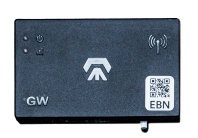This guide is for tracking utilization. For automated cycle counts, read this guide.









Place the aggregator inside the machine’s power panel (or outside panel if using an external sensor).

If an existing aggregator is installed: Connect the new aggregator via CAT5 cable to the existing device's second CAT5 jack.
If there is no existing device: Connect the aggregator to the gateway via CAT5 cable using either CAT5 jack.

Check for a solid blue LED light in the lower left corner of the digital aggregator.
This indicates power and successful gateway connection.





Amper will automatically look for a production sample. If we are unable to find one, we’ll contact you to provide it manually.
If you'd like to check in on the process, check out these two resources:
1. Action items. Navigate to Settings > Hardware. At the top, you'll see a summary of any machines need attention. Each action item (if any) will detail what needs to be done and who is responsible (whether your team or the Amper team).
2. Calibration status. Navigate to Settings > Calibration Status. This dashboard lets you check the calibration status of all your machines. Each machine will have its corresponding hardware details, calibration status, and latest update timestamp.